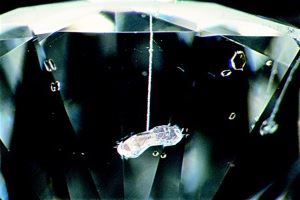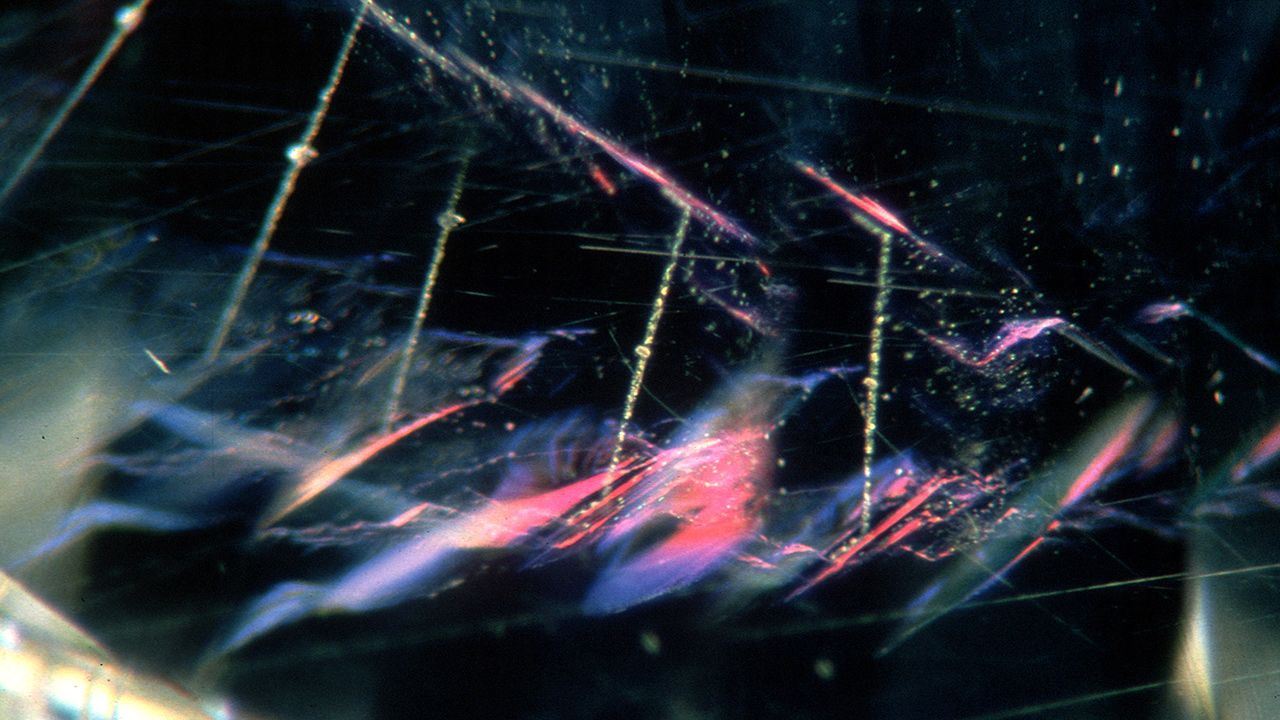DIAMOND TREATMENTS
Diamond TreatmentsTreatment or enhancements to natural diamonds with the goal of improving the diamond's overall appearance are common. These treatments are acceptable and have their place in the jewellery industry, provided the consumer understands whether a particular diamond was treated and exactly what enhancement/treatment was performed on the diamond and why. Some diamond treatments are less durable that others, meaning that the appearance of the diamond may change over time. Treated diamonds are a way for consumers to own lovely jewellery at affordable prices. Laser drilling This treatment is done to reduce or eliminate dark "flaws" (inclusions) in natural diamonds. A laser beam is used to drill a narrow path to the flaw. This path looks like a fine white thread starting at the surface travelling to the inclusion. The effects of the laser treatment are permanent and the diamond does not need special care. A laser-drilled diamond is an affordable alternative to paying more for a natural untreated diamond. Fracture filling Fracture filling is a treatment to improve the appearance of a natural diamond. Surface cavities or fractures which reach or break the surface of a diamond, are filled with a substance (often times a type of epoxy or resin). This treatment does not remove the cavities or fractures but makes them appear less visible. Fracture filling is not a permanent treatment since the heat of a jeweller's torch as well as ultrasonic cleaning can affect the filling used in the treatment. For example: the filling sometimes dries and therefore the cavities or fractures might reappear. Selling a fracture filled diamond requires the seller to fully disclose and explain the treatment, and any special care requirements. Selling a fracture filled, treated diamond without proper disclosure is not an acceptable jewellery trade practice. Additionally, heat must never be applied to a treated diamond; it should always be removed from the setting before any repair work is completed. A customer must advise their jeweller if a stone is treated so that any work being completed on a piece of jewellery is adequately handled. Failure to advise the jeweller may result in damage to the diamond and further costs for the customer, as a jeweller will not be liable if any treatments were not declared. Created Moissanite Moissanite, (chemical compositions: silicon carbide), is a laboratory-created, near-colourless jewel. While Moissanite closely looks like a natural diamond, it is not a diamond, synthetic diamond, brand of diamond nor is it marketed as a diamond substitute. Rather moissanite is marketed as a unique jewel. However, some people do purchase it as a diamond alternative. |
Image: Diamond simulants can look like the real thing to the untrained eye. Do you know what you're buying? |
Know What You're Buying Buying a diamond is an exciting process but can also be very confusing. Scientific and technological advances in the jewellery industry have made it possible for synthetic diamonds/laboratory-created diamonds to be manufactured. There are even some very good imitations – you need to know what you are buying. Synthetic diamonds also known as laboratory-created diamonds or laboratory-grown diamonds. Synthetic diamonds are NOT imitation diamonds. Synthetic means the product is made by man, in a laboratory, using the same chemical substance (pure carbon) found in natural diamonds. A synthetic diamond has the same physical, chemical and optical properties as a natural diamond. It's cut like a natural diamond but a synthetic diamond is created by man, not by Mother Nature. Synthetic, laboratory-created diamonds or laboratory-grown diamonds are less expensive than their natural counterparts. Don't be fooled by look-alikes or imitations. There are many varieties of diamond look-alikes or diamond imitations. These products are not diamonds. If you decide to buy a diamond simulant or a stone that closely resembles a natural diamond, but the stone is not a diamond, be sure you know what you are buying. It's easy to be fooled. Simulant, diamond simulant or simulated stones are imitations. A simulant or simulated stone IS NOT a diamond but rather an imitation man-made product that resembles a diamond. A diamond imitation should not be confused with a synthetic diamond which possess essentially the same physical, chemical and optical properties of a natural diamond. An imitation or diamond simulant can be made of glass, plastic or some other compound such as zirconia oxide, better known as CZ or cubic zirconia. Simulated/imitation stones are made by man and are usually very inexpensive to manufacture. Simulant/imitation stones should not be confused with synthetic diamonds. Be aware that seller of imitation diamonds may use names that confuse consumers into believing that they are natural diamonds and not imitations. Remember if a stone is advertised as a diamond simulant or diamond alternative, it IS NOT a natural diamond nor is it a synthetic diamond. It is an imitation. Be sure to ask if the stone you are buying is a natural diamond. Remember only a natural diamond can be identified using only the word "Diamond", no other description is needed. Be wary when you see a name or word before or after the word "diamond". Example: Royal Diamond, Diamond Extraordinaire. Question the true identity of the stone. Ask the question "Is it a natural diamond?" The answer is a simple yes or no. "The same as" or "Just like" Don't be fooled into believing that one product is necessarily the same as or just like another. Natural diamonds are different to synthetic diamonds and diamond simulants such as CZ. Remember that simulants such as a CZ are not diamonds. While these products offer consumers options, it's so important to know what you're buying - ask questions and get the facts in writing. |
Privacy + Refunds Policy | Media Policy | Site Map | Terms | Contact | © Copyright 2025 |
The Jewellers Association of Australia acknowledge the Traditional Owners of the land where we work and live. We pay our respects to Elders past, present and emerging.
We celebrate the stories, culture and traditions of Aboriginal and Torres Strait Islander Elders of all communities who also work and live on this land.



